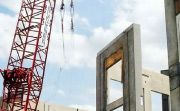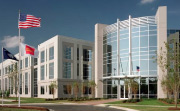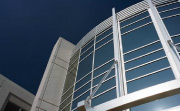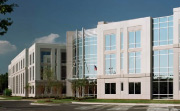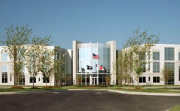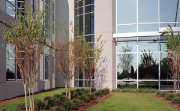Wells Fargo Home Mortgage - Charlotte Servicing Center
Why Did the Owner Select Tilt-Up?
The owner is a real estate development company that was in competition with other developers for a large Built-To-Suit client. The owner approached the General Contractor for help on how to gain a competitive edge on the competition while maintaining the quality level of their buildings that have been their standard for office building projects. This proposed building was to be the signature building in a new business park the owner is developing. The General Contractor suggested using site cast Tilt-Up concrete wall panels in place of pre-cast concrete wall panels normally used on all their multi-story office buildings. The use of Tilt-Up would reduce the construction costs and construction schedule without reducing the quality and appearance of the developer's standards for offices buildings.
What was the Project Mission?
Crescent Resources' goal for this project was to provide their tenant, Wells Fargo Home Mortgage, the character of a 'Class A' office building with more economical materials and construction methods. This would in turn allow them to offer a lower lease rate to their tenant. The Design and Construction teams supported this goal by taking the "Tilt-Up Wall" construction method beyond the "norm" and utilizing the inherent flexibility of concrete.
What was the success of the project?
In all respects, this project was a success for Crescent Resources. Tilt-Wall construction allowed them to provide their tenant with a competitive lease rate while making the space available to them months earlier than traditional office construction methods would have allowed. Additionally, Crescent Resources was able to sell the building to an investment fund immediately after building completion. This is evidence of the further acceptance of Tilt-Wall office construction within the Real Estate community.
What were the special architectural treatments?
The design strategy was meant to mitigate the challenges presented by the overwhelming length of the building and the flat, planar feel so often associated with tilt-wall construction. While accomplishing this, the teams had to keep the solution easy to construct and efficient in design to keep the project on time and on budget. The first step to accomplish this was to focus on the panel design and employ various treatments to overcome the aforementioned challenges.
Reveals and Plane Shifts: By taking advantage of concrete's readiness to take any form, the project team instituted a pattern of recessed planes within the panels to create a sense of depth between the pilasters. Reveal patterns were used to reinforce the verticality of the pilasters while also disguising the panelization of the skin.
EIFS Accents: A single EIFS band was applied to the panels to provide a projecting element that helped delineate the base element of the building from the upper levels while providing additional depth to the panels.
Paint: A two tone textured paint scheme was utilized to reinforce the expression of the base element and the recessed plane. The darker of the two coatings is used exclusively on the base area to further delineate that traditional building element. On the upper levels the darker paint is used on the recessed areas of the panels to accentuate the difference between the pilaster.
Glass: As a final effort to provide more depth within the panel the window system is recessed as much as possible within the panel opening taking advantage of the thickness of the skin. What were the outstanding features? On a larger scale, the overall design of the building incorporated architectural features that created more depth to the façade as a whole while breaking up the length of the facility. The footprint was split into two wings with a center connecting element acting as a ball joint between the two masses. This center connecting piece was accentuated in two ways. The repetition of the panel elements in the wings discussed above formed a rhythmic field against which the dynamic forms of the fragmented cylinder and monolithic concrete piers in the center piece signal the location of the main entrance. Additionally, the way the two wings were separated and rotated, set up a large recessed area at the center piece which creates additional depth. Within the confines of the each wing, the building mass is further broken down through the judicious use of curtainwall and panel return legs. Three different depths in the wing facades are set up by using a bay of curtainwall between the corner masses and the center mass of panels. By employing all of the above architectural treatments and features the project team was able to create an aesthetic that provides depth of field, de-emphasizes the extreme length of the facade, presents itself as a much more expensive material and construction method.
What was the Overall Complexity of the project?
The use of Tilt-Up concrete wall panels for a building project that typically used architectural pre-cast concrete walls panels created a complexity for the architect, structural engineer, and contractor. The complexity involved the use of multi-story window openings in load bearing panels, wall openings equaling 40% of the exterior wall area, large and deep recessed areas in the panels, reveal patterns with differing depths and edge types, and jogs in the exterior walls requiring monolithic L-shaped panels with nominal leg return lengths of 1'-0" or 3'-0". The use of multi-story Tilt-Up panel braces attached to the interior floor area also created safety and interference concerns for the steel erector during installation of the first floor steel beams. The two-story high wall openings created a problem for floor support behind the openings. The use of a composite steel beam and concrete floor system in place of a steel bar joist and concrete floor system allowed the floor beams to straddle the window openings and attach to the panel legs with a 3" composite steel deck spanning between the beams. The large amount of wall openings created a reduction in panel bearing area that was accommodated by locating all floor beam connections at the panel legs. This required varying the floor beam spacing throughout the building to match the exterior panel leg locations. The large amount of panel recesses and reveals required a good casting surface, high quality forming materials, precision carpentry with strict attention to layout. This was accomplished by the use of a high quality Tilt-Up contractor with experience in this area. The L-shaped panels were required to be monolithic for appearance. This was accomplished by using strong wood form structures typically used for cast-in-place walls. The form structures were designed with one side bearing and braced on the floor bearing side. The form structure was designed to withstand the impact of concrete placement and the pressure of the concrete on the forms from a 3'-0" height of wet concrete without moving or affecting the appearance of the panel. Pre-planning and coordination between the steel erector and Tilt-Up contractor accomplished the first floor steel erection around the panel braces. The panel braces were located away from beam locations eliminating and interferences and lessening the problem with safety.
What additional features or comments should be made?
Prior to starting the project, the building owner and steel fabricator were very skeptical about the use of Tilt-Up for this type of project due to the concern with quality of the panels by the owner and the erection difficulties of a load bearing Tilt-Up wall panel by the steel fabricator. By the end of the project, the owner was impressed enough with the finished building that they started bidding on more office projects utilizing Tilt-Up construction rather than using pre-cast concrete. In addition to this, the use of Tilt-Up wall panels at the stair wells and elevator shafts allowed the elimination of interior steel braced frames by utilizing the stair and elevator shaft walls as shear walls for lateral stability.
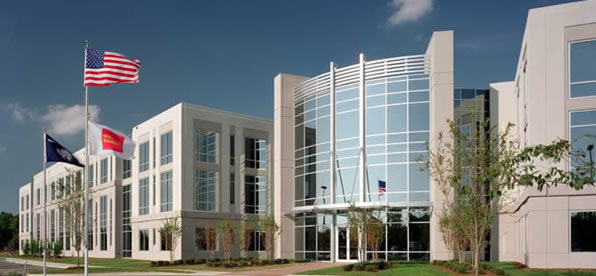
Project Location
Fort Mill, SC 29715
United StatesA
TILT-UP ACHIEVEMENT AWARD
The Tilt-Up Achievement Awards were established to honor projects that use site-cast tilt-up concrete to introduce new building types, advance industry technology and provide unique solutions to building programs. Winning entries illustrate the variety, beauty, and flexibility of tilt-up construction.
ACHIEVEMENT
2003
The world’s greatest tilt-up structures are featured by the TCA as Tilt-Up Achievement Award Winners. Learn more >
Project Images
Project Team (TCA Members)
- Developer/Owner:
- General Contractor:
- Concrete Contractor:
- Citadel Contractors, Inc.
- Architect:
- Engineer:
- Leviat
- Suppliers:
- Leviat
- Photographer(s):
Project Specifics
- Project Category:
- Office
- Building Types:
- Finishes:
- Features:
- Insulation:
- Environmental:
- Number of Floors:
- 0
- Tallest Panel:
- 48 ft 6 in (14.78 m)
- Largest Panel:
- 1,073 sq ft (99.7 sq m)
- Heaviest Panel:
- 83,000 lbs (37,648 kg)
